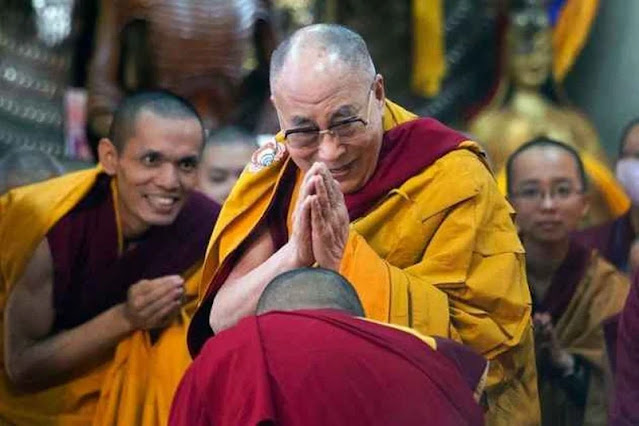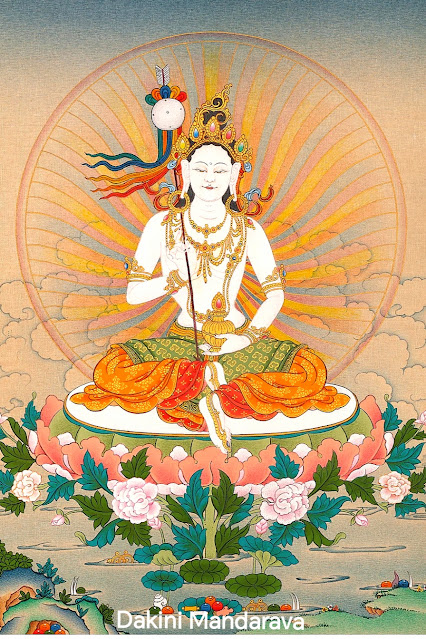A mantra—literally “that which protects the mind”—is a series of Sanskrit syllables that evoke the energy of a particular Buddha or Bodhisattva. It works as a sacred sound that brings blessings to ourselves and others and as a tool to transform our mind into one that is more compassionate and wise.
Introduction
For thousands of years, in a wide range of cultural traditions, people have been using sounds in a variety of ways to contribute to health and well-being. There are traditional songs, chants, and music to accompany many social activities.
In some indigenous tribes, virtually every activity is preceded by a ceremonial chant, whether it is hunting, gathering or preparing food, going to war, marriage or any type of celebration. These chants help to prepare the participants mentally, physically, and spiritually for the coming event.
In this article, we will focus on one aspect of this common practice: the use of certain vocalized ‘power sounds’ that we will call mantras. We will look at information about mantras and discuss some of the ways that they can affect human consciousness.Vibrational meaning
What are mantras? Why do they have such a strong capacity to affect us? To answer these questions, we must first acknowledge that sound, in general, has a powerful effect on human consciousness.
Some sounds, such as nails on a blackboard, are irritating, while other sounds, such as a gently babbling brook, soothe us. For the most part, all humans tend to react to these
sounds similarly, although there may be some variation as to which sounds affect which people. It may be useful to think of a sound as a relationship of frequencies.’
Every single, solitary sound is a vibration with a specific frequency. Most of the sounds we hear consist of several sounds combined, or a collection of frequencies. It is the way that these frequencies relate to each other that determines the way they affect human consciousness.
With noise or discordant sound, the frequencies have no mathematical relationship with each other. In music, the frequencies (the notes) relate to each other. They are in harmony with each other and are more naturally pleasing to the ear.
A good way to understand a mantra’s power is to look at the way a chord affects us in music. A major A chord, which is a harmonic relationship of three frequencies or notes, has a built-in emotional quality, an inherent way of affecting human consciousness.
It makes us feel a certain way. A minor chord, which is a different harmonic relationship of three notes, has a completely different emotional quality than the major chord. It affects us completely differently. Humansseem to recognize and react to these sounds in a similar way. It is built-in.
We don’t know why it affects us this way—it just does.Similarly, a mantra is a collection of sounds, a relationship of frequencies. Every mantra has an innate ability to affect human consciousness. Said another way, each sound and each syllable have a natural, inherent power.
Certain combinations of these sounds have a ‘vibrational meaning,’ a vibratory quality that relates to aspects of humanity and divinity. Repeated exposure to these sounds can bring about a shift in human consciousness, bringing that consciousness into harmony with that vibratory quality.A mantra has the built-in power to balance energy and change.Our beliefs change the way we act, think, and feel. We’re not sure exactly how it works. I believe that some ancient root languages, such as Hebrew and Sanskrit, and some indigenous languages were built upon this realization, so that the vibrational meaning of certain sounds contributed to the literal meaning of words.
It seems likely that, back when human consciousness was more right-brained and intuitive, the language was developed in such a way that there was a truer connection between the vibrational meaning and the literal meaning of a ‘word.
Our modern languages, developed during a time when human consciousness was more left-brained and less intuitive, seem less connected in this vibrational way.Some mantras evolved to become the names of deities. In other words, the sounds that represented a certain set of human or divine qualities were eventually assigned a divine persona. and the sound became the name of that persona, that deity.
These deity names and mantras are believed, in many traditions, to have power even when they are in the form of a thought. In other words, the name itself has been identified as carrying power.
It appears likely that the actual sound of pronouncing the name may lend it further power, although the written name and a mental focus on the name are also said to carry power.
If we broaden our standard definition of the word sound,’ we can view a thought as a type of sound in that it is also a vibratory expression. Some traditions believe that a thought form is like an electromagnetic transmission.Chanters in the study also reported what mantra chanters have known for thousands of years: mantras have the power to sooth anxiety and create joyous feelings. It's believed that the sound vibrations produced during mantra chanting stimulate and balance the chakras (energy centers of the body).
Chanting mantras helps to heal the body, protect the mind, and manifest human desires by connecting the person who is chanting with the divine.
Donations for our Buddhist research and development.









































